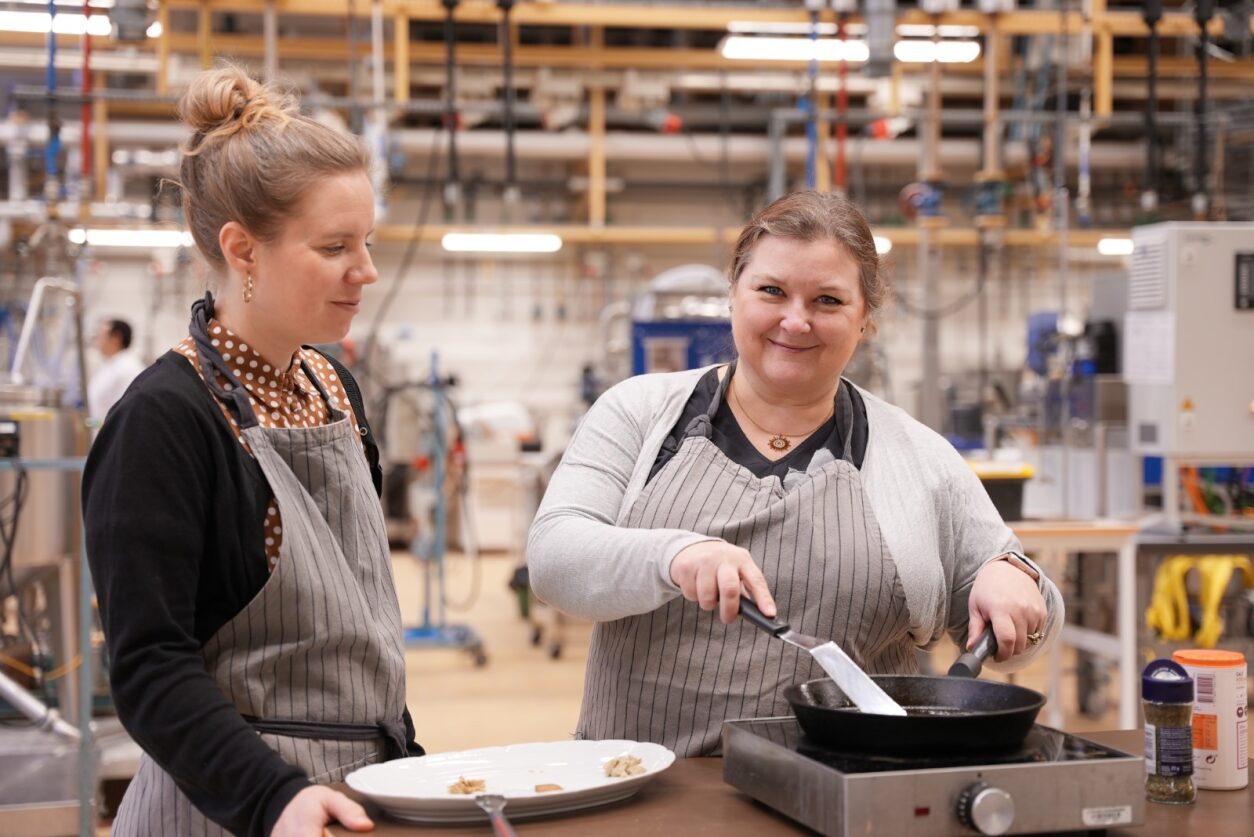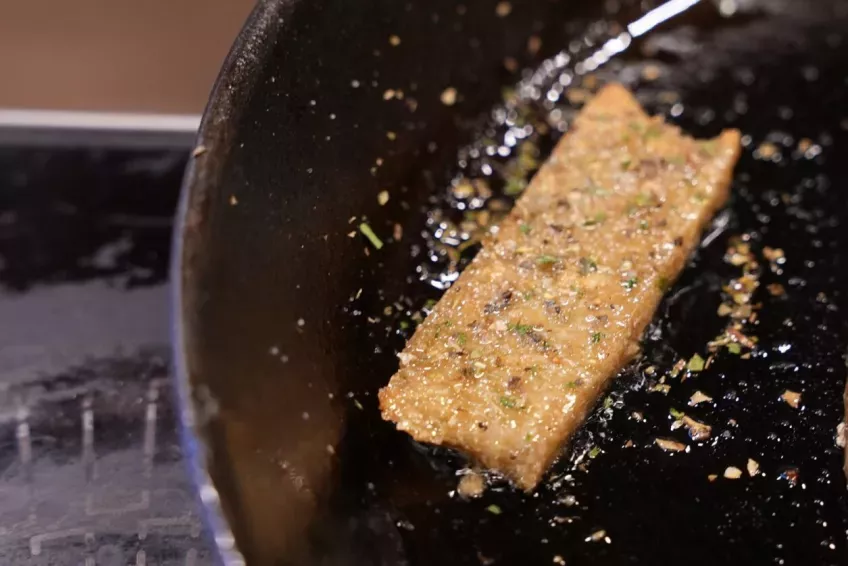Unique manufacturing method produces more appealing vegan meat
Vegan food is often sidestepped due to its rubbery consistency. Food technology researchers at Lund University in Sweden have now developed a way to make vegan food more appetising by using new combinations of raw materials. So far, the research field for plant-based meat imitations, known as meat analogues, has been very small - but is now set to “explode”. The team at Lund is among those that have published the most research in the world on the topic.
– Published 6 March 2024

The research is similar to that surrounding cultivated meat. However, instead of cultivating meat by using stem cells, researchers work with with plant protein as a means to imitate the fundamentally different muscle fibres.
An evaluation of several crispy “meaty” plant-based products was recently carried out. Some were rated highly, but one stood out as the winner. Texture and temperature are just as important as taste for how food is sensed in the mouth.
“This is generally referred to as the three “Ts”: texture, temperature and taste. Texture, or consistency, affects how much we like the food, just as much as taste, although we are not always aware of it. Both have to work,” says Jeanette Purhagen.
She is a researcher in food technology at Lund University and develops new ways to make appetising food from different types of residual streams generated by the food industry – with benefits for the environment, climate, health and animals. Food texture is her area of specialist expertise.
Imitation of muscle fibres
The vegan food currently in supermarkets– often containing imported soy protein as the main ingredient, or other types of bean and vegetable burgers – lacks the fibre structure required to provide the chewiness that people appreciate.
“If, for example, you take mashed potato and fry it, your teeth go straight through, it is just soft and fluffy. When you chew meat, it is a totally different sensation. With the help of technology, we want to introduce chewiness into vegetable-based foods by imitating muscle fibres,” says colleague Karolina Östbring.
“Tricky but wonderful when it works”
The production of the sought-after meat analogues involves a complex piece of equipment called an extruder. It is the only equipment that can produce meat analogues with good, long fibres. In short, it can be described as a combined pressure cooker and meat grinder.
Karolina Östbring and Jeanette Purhagen have worked intensively with the equipment for five years. According to Östbring it is “incredibly complicated”.
“My goodness, it is the most advanced equipment we have in our machine hall. This is because there is an immense number of parameters that can be set at an immense number of levels. It means that it is tricky but wonderful when it works,” she says.
Now the researchers have got the hang of the machine. A lot has been published already, and more studies are on the way.

One of the products from the research team
Discovery saves 75 per cent of energy consumption
They have also made a discovery that saves a lot of energy and thereby enables more climate-friendly products. Instead of the usual process of feeding the extruder with a dry powder, they introduce a protein solution through an input that is actually for clean water. This method skips an energy-intensive drying stage while the extruder uses less energy. Overall, energy consumption is reduced by about 75 per cent.
“It was not possible to patent the discovery, as the whole patent system is based on adding a step, rather than removing and simplifying. So, we have now published the discovery instead,” says Jeanette Purhagen.
This means that the Lund team is currently the only one producing meat analogues in this way.
A combination produces the best results
Finding the optimal combination of vegetable proteins to feed into the machine is just as important as finding the right settings for the extruder.
The researchers have experimented with, among other things, rapeseed, hempseed, yellow peas, chickpeas, broad beans, oats and gluten (from wheat), often in the form of protein and fibre-rich residues from agriculture and the food industry, which further increase the environmental benefits.
“The research field has begun to realise that one raw material cannot do the whole job, rather you need to combine two or more raw materials to attain a really good mouthfeel. Often you need a raw material that adds protein and one that contributes fibre, so that the product won’t be too rubbery,” says Karolina Östbring.
Taste is also a challenge, as many plant components cause a bitter taste that can be difficult to filter out.
Favourite combination
So, which one was rated most highly?
“Hempseed behaves in a really tremendous way,” notes Karolina Östbring and adds that industrial hemp is used, more specifically the press cake left over from hempseed oil production.
“This residue contains a lot of high-quality protein, it has fantastic texturing properties and tastes good,” says Karolina Östbring. “The plant can be grown in Sweden and what is left over can be used for textiles and building material.”
Used with gluten, the hempseed acquired a rounded taste and a good chewy texture that was appreciated by the panel. This combination was selected as the favourite.
The next-best rated combination was hempseed and residues from oat milk production.
While the researchers themselves aren’t commercialising the product, there is interest from several companies. This process could take between two and five years.
Facts: Meat analogues
A meat analogue is a food that has the mouthfeel of meat but is made from a protein-rich plant material. Bean and vegetable burgers, which have little chewiness and fall apart easily, are not classified as a meat analogue. At present, meat analogues are only made from soya, seitan and, on a limited scale, yellow peas.
Most are low-moisture extruded, i.e. made with a low water content. These products leave the extruder in a state similar to dried minced meat and need to be soaked and shaped into products. There is now a fast-growing interest in producing meat analogues with a high moisture content that better imitate the full muscle structure of meat – high-moisture meat analogues. The food technology research team in Lund is at the very forefront of research regarding meat analogues made from alternative proteins.
Facts: Extruders
An extruder can be described as a combined meat grinder and pressure cooker. When the plant protein material is kneaded, heated and pressurised, this creates a fibre structure that has chewiness.
The extruder was initially developed in the plastics industry. In the 1950s, it was modified slightly to produce breakfast cereals and snacks. During the 1970s, it started to be used for soya protein products. Researchers began to experiment with other plant proteins in the 2010s.
In the conventional process, a dry powder is fed in and then mixed with a small percentage of water – low-moisture extrusion. If the powder has a large proportion of starch, it becomes snacks or breakfast cereals. If the protein content is high – usually soya – meat analogues are produced.
There is now an exploration of the potential offered by directly feeding the extruder with a high-moisture protein material that makes a finished product without involving a powder stage. Using this approach, the taste and texture are better. The energy costs are also reduced, as the moisture does not need to be removed at the start and then readded later.
Publications:
Link to studies:
https://www.sciencedirect.com/science/article/pii/S0023643823010733
https://www.mdpi.com/2304-8158/9/6/772
https://www.sciencedirect.com/science/article/pii/S0260877423001656
https://www.mdpi.com/2304-8158/11/18/2870
https://www.mdpi.com/2304-8158/10/10/2397
https://pubmed.ncbi.nlm.nih.gov/33924424/
